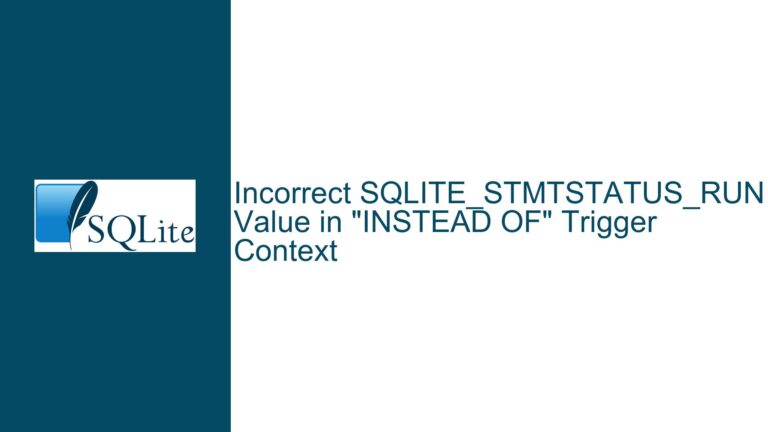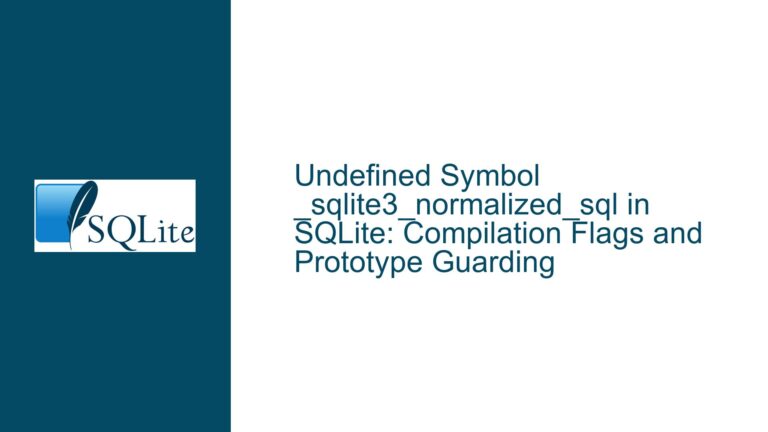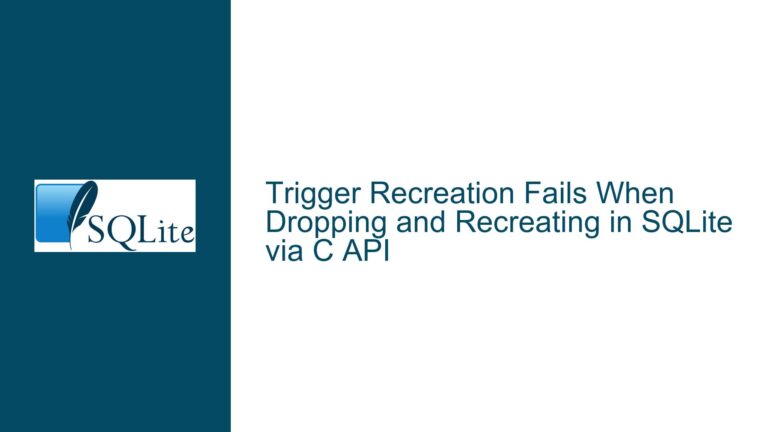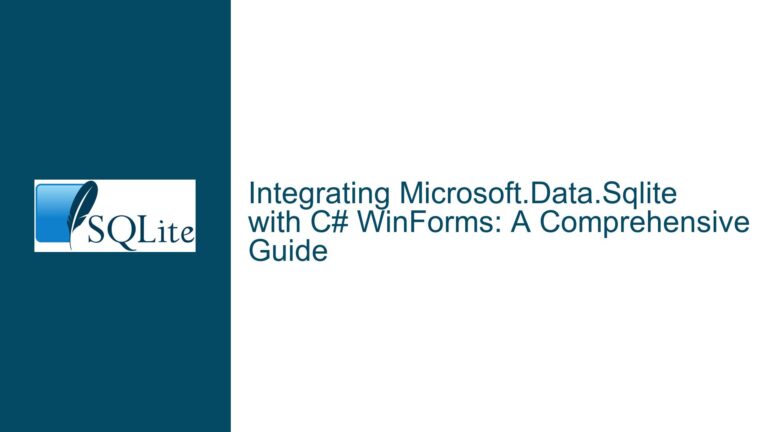Loading Custom SQLite Libraries in .NET with AssemblyLoadContext and System.Data.SQLite Integration Challenges
Dynamic SQLite Library Loading in .NET: Core Technical Constraints and Workarounds
The central challenge involves integrating a custom SQLite library (SQLITE3.DLL) loaded via .NET’s AssemblyLoadContext with System.Data.SQLite, a widely used ADO.NET provider. Developers often attempt this to achieve version isolation, side-by-side SQLite instances, or to bypass platform-specific dependencies. However, the architecture of System.Data.SQLite imposes rigid constraints due to its static binding to a specific SQLite version during compilation. This creates conflicts when attempting to override the library’s native dependency resolution mechanism.
A critical nuance lies in the distinction between static linking and dynamic linking in the context of .NET wrappers for SQLite. When System.Data.SQLite is compiled, it embeds a specific SQLite version directly into its binary (static linking). This eliminates runtime dependencies on external SQLITE3.DLL files but also makes it resistant to attempts to override the SQLite engine via traditional dynamic library loading techniques. The AssemblyLoadContext mechanism, designed primarily for managed assemblies, does not inherently resolve native library dependencies, further complicating scenarios where developers want to inject a custom SQLite binary.
The interplay between Windows API functions like SetDllDirectory, the .NET runtime’s native library resolution logic, and System.Data.SQLite’s internal architecture must be dissected to identify viable workarounds. For instance, while SetDllDirectory can influence the search path for dynamically linked libraries, it has no effect on statically linked binaries. This creates a fundamental mismatch between the problem (loading a custom SQLite library) and the solution space (modifying runtime behaviors of a pre-linked binary).
Root Causes of SQLite Library Loading Failures in System.Data.SQLite
Static Linking of SQLite in System.Data.SQLite Binaries
The primary obstacle stems from System.Data.SQLite’s design: it compiles SQLite directly into its own binary. This static linking ensures that applications using this provider do not require a separate SQLITE3.DLL file. However, it also means that all SQLite API calls are resolved at compile time, not runtime. When a developer attempts to load an external SQLite library via AssemblyLoadContext or SetDllDirectory, System.Data.SQLite continues using its embedded SQLite engine, ignoring the externally loaded library.
Incompatibility Between AssemblyLoadContext and Native Library Loading
AssemblyLoadContext is a .NET Core+ feature enabling isolation and explicit loading of managed assemblies. However, its control over native libraries (like SQLITE3.DLL) is limited. Even if a custom SQLITE3.DLL is loaded into memory, System.Data.SQLite has no mechanism to bind to it because its internal P/Invoke declarations are hardcoded to use the statically linked SQLite symbols. The .NET runtime’s native library resolver does not override static linkages, rendering AssemblyLoadContext ineffective for this purpose.
Misuse of SetDllDirectory for Static Binary Redirection
The Windows API function SetDllDirectory modifies the search path for dynamically linked libraries (DLLs). However, this function is irrelevant for binaries that statically link their dependencies. Since System.Data.SQLite does not dynamically link against SQLITE3.DLL, calling SetDllDirectory before initializing the provider has no effect on its behavior. Developers often misinterpret this function as a universal solution for DLL redirection, leading to frustration when it fails to influence statically linked components.
Strategies for Custom SQLite Library Integration in .NET
Verify Static Linking and Identify Provider-Specific Constraints
First, confirm whether the System.Data.SQLite build in use is statically linked. Check the provider’s documentation or inspect its dependencies using tools like Dependency Walker or dumpbin /headers. If the provider has no external SQLite dependency (no SQLITE3.DLL requirement), static linking is confirmed. In this case, loading a custom SQLite library via AssemblyLoadContext or SetDllDirectory is inherently impossible.
Bypass System.Data.SQLite and Use Direct SQLite API Calls
If using System.Data.SQLite is not mandatory, consider interacting with SQLite directly via P/Invoke. This approach requires declaring SQLite’s C API functions in C# and manually loading the SQLITE3.DLL library.
Step 1: Load SQLITE3.DLL Using Native Methods
Use AssemblyLoadContext or NativeLibrary APIs to load the custom SQLite library:
using System.Runtime.InteropServices;
// Load SQLITE3.DLL from a custom path
var libraryHandle = NativeLibrary.Load("/path/to/custom/SQLITE3.DLL");
Step 2: Declare SQLite Functions with P/Invoke
Define the required SQLite functions using DllImport or runtime delegates:
[DllImport("SQLITE3.DLL")]
public static extern int sqlite3_open(string filename, out IntPtr db);
// Or use delegate-based resolution for explicit symbol binding
delegate int sqlite3_open_delegate(string filename, out IntPtr db);
var sqlite3Open = Marshal.GetDelegateForFunctionPointer<sqlite3_open_delegate>(
NativeLibrary.GetExport(libraryHandle, "sqlite3_open"));
Step 3: Implement a Minimal ADO.NET Wrapper
Create a lightweight wrapper around the native SQLite API to replicate System.Data.SQLite functionality. This includes managing connections, commands, and result sets.
Leverage Microsoft.Data.Sqlite for Dynamic Library Loading
The Microsoft.Data.Sqlite provider (maintained by the .NET team) supports dynamic SQLite library loading via the SQLitePCLRaw subsystem. This provider explicitly allows runtime configuration of the SQLite engine:
Step 1: Install Required Packages
dotnet add package Microsoft.Data.Sqlite
dotnet add package SQLitePCLRaw.bundle_dynamic
Step 2: Configure Custom SQLite Library Path
SQLitePCL.Batteries.Init();
SQLitePCL.raw.SetProvider(new SQLite3Provider_External("/path/to/custom/SQLITE3.DLL"));
using var connection = new SqliteConnection("Data Source=mydb.sqlite");
connection.Open();
This method bypasses the static linking problem by using a pluggable provider model. SQLitePCLRaw dynamically binds to the specified SQLite library at runtime.
Recompile System.Data.SQLite with Dynamic Linking
If System.Data.SQLite must be used, obtain its source code and recompile it with dynamic linking enabled. This requires modifying the build configuration to link against SQLITE3.DLL instead of embedding SQLite.
Step 1: Download System.Data.SQLite Source Code
Clone the repository from https://system.data.sqlite.org/.
Step 2: Modify Build Configuration
Edit the SQLite.Interop.csproj file to remove static linking options:
<!-- Change from -->
<CompileDefine>SQLITE_STATIC_LINK;</CompileDefine>
<!-- To -->
<CompileDefine>SQLITE_DYNAMIC_LINK;</CompileDefine>
Step 3: Rebuild and Reference the Custom Binary
Compile the modified provider and reference it in your project. Ensure the target environment has the required SQLITE3.DLL accessible via SetDllDirectory or PATH.
Hybrid Approach: Intercepting SQLite API Calls
For advanced scenarios, consider hooking into the SQLite API calls using function interception techniques. Tools like Detours (on Windows) or LD_PRELOAD (on Unix-like systems) can redirect calls from the statically linked SQLite to a custom library.
Step 1: Create a Proxy DLL
Develop a proxy DLL that exports all SQLite functions. This DLL forwards calls to the custom SQLITE3.DLL while being loaded into the process address space.
Step 2: Use Detours to Redirect Calls
// Pseudo-code for Detours-style redirection
var originalSqlite3Open = Detour.FindFunction("SQLITE3.DLL", "sqlite3_open");
Detour.TransactionBegin();
Detour.Attach(ref originalSqlite3Open, CustomSqlite3Open);
Detour.TransactionCommit();
This method requires deep knowledge of native code and platform-specific interception mechanisms.
Fallback: Process-Level Isolation for Multiple SQLite Versions
If all else fails, isolate different SQLite versions into separate processes. Use inter-process communication (IPC) or a microservices architecture to handle database operations. For example:
Step 1: Develop a Companion Process
Create a lightweight executable that uses the desired SQLite version via Microsoft.Data.Sqlite or direct P/Invoke.
Step 2: Communicate via Pipes or Sockets
// Main process
using var client = new NamedPipeClientStream("MySqlitePipe");
client.Connect();
var writer = new StreamWriter(client);
writer.WriteLine("SELECT * FROM my_table;");
writer.Flush();
// Companion process
using var server = new NamedPipeServerStream("MySqlitePipe");
server.WaitForConnection();
var reader = new StreamReader(server);
var query = reader.ReadLine();
// Execute query using custom SQLite library
This approach sidesteps the static linking issue entirely but introduces complexity in managing concurrent processes and data serialization.
Critical Considerations for Production Environments
- Performance Overheads: Direct P/Invoke or IPC-based solutions may introduce latency compared to native
System.Data.SQLiteusage. - Platform Compatibility: Solutions involving
SetDllDirectoryor Detours are Windows-specific. Unix-like systems requireLD_LIBRARY_PATHordlopenequivalents. - License Compliance: Ensure custom SQLite builds comply with SQLite’s public domain license and any third-party provider requirements.
- Debugging Challenges: Mixing static and dynamic SQLite linkages can lead to cryptic errors. Use diagnostic tools like Process Monitor (Windows) or
strace(Linux) to trace library loading issues.
By methodically evaluating these strategies against project requirements, developers can circumvent the limitations of System.Data.SQLite’s static linking while achieving custom SQLite library integration in .NET applications.






